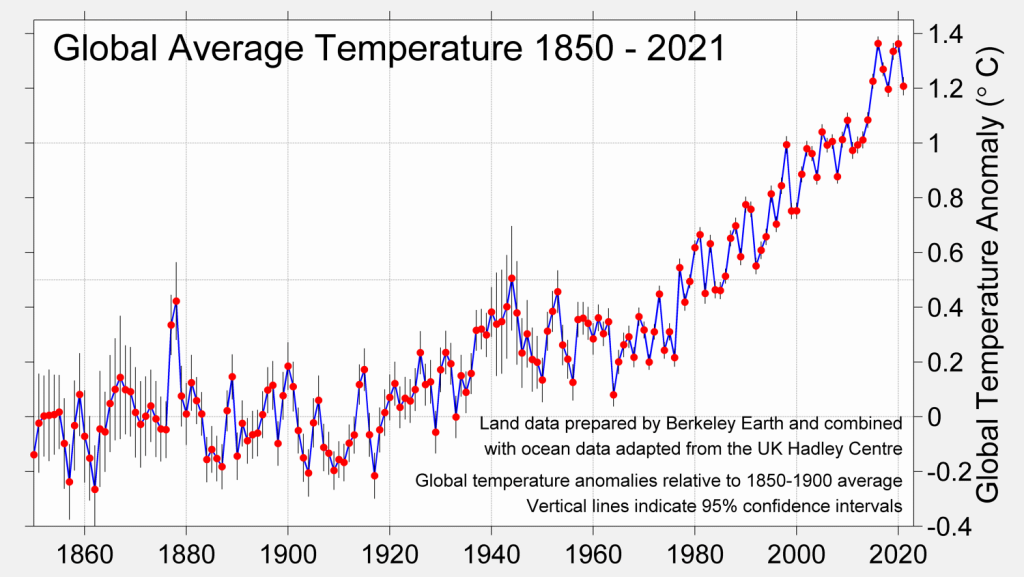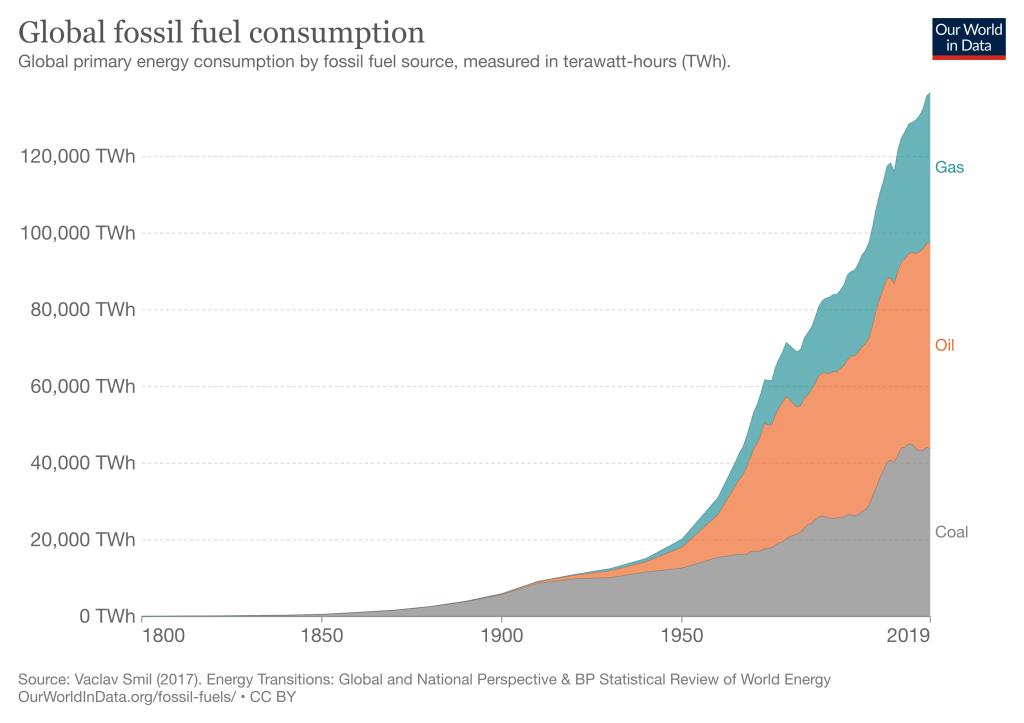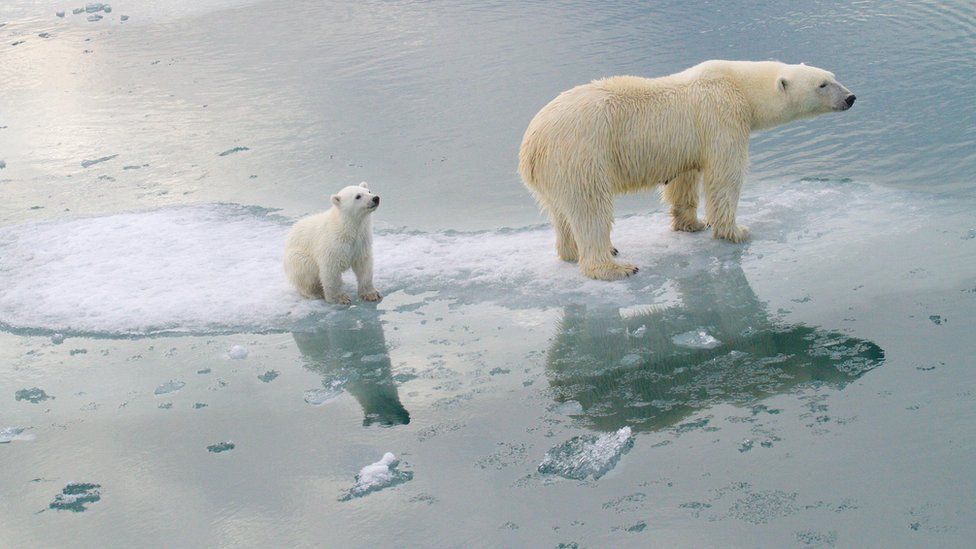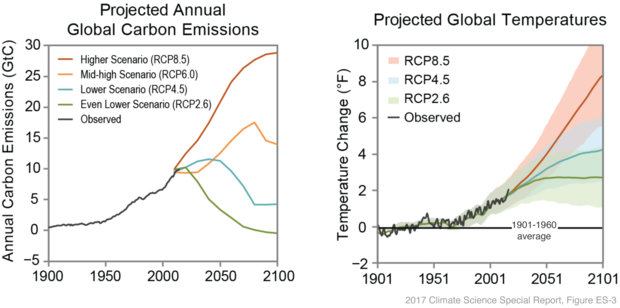Teen Science Café: The Growing Threat of Climate Change
By Myla Leung, Teen Science Cafe Outreach Officer
“Climate change is real, and it’s here now,” warned Dr. Sara Via in her Teen Science Cafe presentation. Via is a Professor and Climate Extension Specialist at the University of Maryland, and in her presentation, she discussed the very real consequences of climate change and ways to mitigate these consequences.
Via started off her Teen Science Cafe with a graph displaying global average temperatures from 1850 to 2021. Alarmingly, the graph indicated that in the last 7 years, the temperature has been the highest in human history. In fact, “19 of the 20 hottest years on record have occurred after 2000,” Via pointed out.

Graph Source: Berkeley Earth
The reason for these rising temperatures? The Greenhouse Effect. According to NASA Climate, “The greenhouse effect is a process that occurs when gases in Earth’s atmosphere trap the Sun’s heat. This process makes Earth much warmer than it would be without an atmosphere.” Similar to greenhouses that “get very hot when it’s sunny because glass slows down heat loss,” Via explained, greenhouse gases trap and hold the Sun’s heat in the Earth’s atmosphere.
Furthermore, certain greenhouse gases interfere with heat waves as they move toward space. These gases include carbon dioxide, methane, and nitrous oxide. Interference by these gases slows heat loss from the Earth, causing the air to warm. Thus, with more greenhouse gases, there will be a greater rise in the Earth’s temperature.
The culprit behind Earth’s rising temperature, however, is not solely greenhouse gases. Humans, Via stresses, are responsible for increasing greenhouse gases and therefore increasing temperatures. Human activities, in particular the burning of fossil fuels, are what initially produce more greenhouse gases in Earth’s atmosphere.

Graph Source: Our World in Data
Next, Via transitioned to a discussion of global warming, highlighting that most heat created from greenhouse gases is contained in oceans. “With warmer oceans, there will be more evaporation, more humidity, higher sea level, and changes in currents,” said Via. These warmer effects have unfortunately become the “new normal” and can prove dangerous to both humans and wildlife.
Rising sea levels, for instance, can risk flooding for cities near oceans. Wildlife populations will also be threatened. This is because rising waters will destroy several waterfront ecosystems–ecosystems such as wetlands and estuaries that multiple species of wildlife depend on. Moreover, glaciers will melt and arctic sea levels will rise, endangering polar bears and other arctic species.

Polar bears on melting ice. Source: Katharina M Miller via BBC News
Another consequence of global warming is increased hurricanes. Although climate change does not directly cause hurricanes, it can “make them stronger and more damaging,” Via asserted. Since warmer oceans increase storm energy and fuel hurricanes, more storms will become dangerous. This will also enlarge the area where hurricanes can form. Hurricane Harvey, Michael, Laura, and Delta are all hurricanes that were intensified by global warming.
In addition, there are escalating California wildfires. “These wildfires are because of climate change, people, reduced fire suppression, and Santa Ana winds,” said Via. More specifically, climate change has led to a shorter winter. This, in turn, makes the fire season 2.5 months longer than normal and results in record drought and record heat.
In terms of people, human activity and power lines have worsened the wildlife crisis. As mentioned by the National Park Service, “Nearly 85 percent of wildland fires in the United States are caused by humans. Human-caused fires result from campfires left unattended, the burning of debris, equipment use and malfunctions, negligently discarded cigarettes, and intentional acts of arson.”
Meanwhile, Maryland is witnessing its own consequences of climate change. Since 1950, there have been more days over 80°, more nights over 70°, longer heat waves, warmer urban areas, and extreme heat. It may not seem like a cause for concern, but extreme heat is the “most common cause of death from climate change,” Via emphasized. On the other hand, there have been milder winters and a longer warm season, meaning insects, ticks, and weeds will emerge earlier.
Whether it is wildfires or flooding, climate change is taking a toll on Earth and its inhabitants–but “We are a decision point, and all of you young people can still choose the future you want,” said Via. First, it is important to recognize that combating climate change is achievable, and it all traces back to human actions.
Being an advocate, fighting misinformation, and changing food choices are all small, yet effective methods of fighting climate change. If teens choose to stay aware, get involved, and reject the untruth, eventually their individual actions will add up. As Via reminds us, “[Teens] may not run the world, but [they] can control [their] part of it.”

Image by Katharine Hayhoe, from the 2017 Climate Science Special Report by the U.S. Global Change Research Program.
References:
Gill, H. B. and V. (2020, July 20). Climate change: Polar bears could be lost by 2100. BBC News. Retrieved March 27, 2022, from https://www.bbc.com/news/science-environment-53474445
Harvey, C. (2015, February 17). Sea-level rise will cause more than flooding – these 5 other impacts of rising oceans are just as bad. Business Insider. Retrieved March 27, 2022, from https://www.businessinsider.com/5-terrifying-impacts-of-rising-sea-levels-2015-2
NASA. (2022, March 7). The causes of climate change. NASA. Retrieved March 27, 2022, from https://climate.nasa.gov/causes/
NASA. (n.d.). What is the greenhouse effect? NASA. Retrieved March 27, 2022, from https://climatekids.nasa.gov/greenhouse-effect/
U.S. Department of the Interior. (n.d.). Wildfire causes and evaluations (U.S. National Park Service). National Parks Service. Retrieved March 27, 2022, from https://www.nps.gov/articles/wildfire-causes-and-evaluation.htm#:~:text=Nearly%2085%20percent*%20of%20wildland,and%20intentional%20acts%20of%20arson.&text=Lightning%20is%20one%20of%20the%20two%20natural%20causes%20of%20fires.
What warmer oceans mean for the planet | CNN. (n.d.). Retrieved March 27, 2022, from https://www.cnn.com/2019/01/12/health/warm-ocean-effects-intl/index.html
About the Author:
 Myla Leung, Teen Science Café Outreach Officer
Myla Leung, Teen Science Café Outreach Officer
Myla is a first Year at Winston Churchill High School and has always had a strong interest in environmental science and sustainability. She’s excited to be a part of the Teen Science Cafe team, and is looking forward to learning about ways we can protect our environment.
Interested in getting involved with the Teen Science Café? Learn more.





